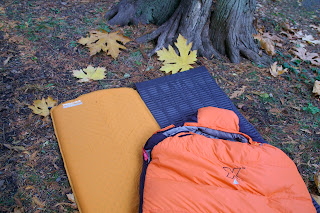Choose a bag that has a rating slightly lower than the coldest temperature you expect to encounter. Zippers that open from both top and bottom allow ventilation options so you don’t overheat when the weather is warmer than your bag rating. Research indicates that women generally prefer a warmer bag than do men. According to the good folks at REI, the following bag ratings apply:
- A summer season bag is rated for 35 degrees F and higher.
- A 3-season bag will range from 10 to 35 degrees.
- A cold weather bag is rated for -10 to +10 degrees.
- A winter bag will be rated for -10 degrees F and lower.
Some cold weather bags are designed to hug your body, while those rated for warmer climates are often rectangular and looser fitting. The best choice is what you’re comfortable with. In a tight-fitting bag, a generous footbox is nice so your feet don’t feel constrained. Try a bag on for size before buying it, to make sure you’ll be okay with the dimensions and overall shape. There are bags especially designed to fit the female body shape, and there are also children’s size bags.
A convenient option for couples is to create a doublewide bag. This is accomplished by having two bags with compatible zippers so the bags can be zipped together to accommodate two people.
High quality synthetic fill material is almost as good as down when it comes to insulation value — it weighs more, doesn’t compress as small, but costs a lot less. Down fails when wet, while synthetics continue to provide insulation value. So, for camping in wet weather, I’m looking for a synthetic fill such as Polarguard, Hollofil, and Micro-loft. For cold weather in a situation where getting wet is not an issue, prime northern goose down is the fill material of choice.
Construction features to look for include:
- Nylon or polyester ripstopsShell material treated with durable water repellent (DWR). The treatment doesn't make the bag waterproof, but it helps moisture bead and roll off the bag instead of soaking into the filler.
- Anti-snag zipper with a flap or baffle that covers the zipper to keep drafts from coming through.
- Tuck stitching or internal tubes or baffles to hold the insulation material in place without through-stitching that would allow cold to penetrate.
- Cold-weather bags should have a hood and collar arrangement to help keep body warmth inside.
- A pillow pocket where you can tuck a shirt or jacket to serve as padding beneath your head.
- A sleeve for inserting a sleeping pad, or external attachment points for connecting to a sleeping pad. This helps keep the pad under the bag, even though you might squirm around a bit in your sleep.
- A stuff sack or roll straps to make packing the bag easier. If the bag doesn't come with a stuff sack or rolls traps, you can buy these accessories at a sporting goods store. In a pinch, you can use bungee cords or a couple lengths of cordage to serve as roll straps.

I've never liked sleeping bags, much preferring blankets.
ReplyDeleteAnd as of late I've quit wearing socks, these one size fits all socks fit too tight and restricts the blood flow, my feet are warmer not wearing socks.
When it's cold I do wear loose fitting insulated leggings, ya gotta keep the blood warm until it gets to your feet.
Restrictive clothing sucks, wear loose clothing, dead air space is a pretty good insulator in itself.